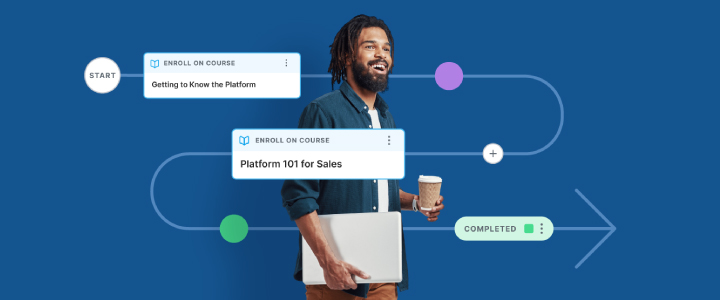
3 min reading time
Agile eLearning: Efficient eLearning Development
eLearning professionals know only too well how daunting the task of creating course content can be. With the imperative end goal of creating engaging, informative courses for learners established, the process of getting there often feels complex and convoluted. That’s where agile eLearning can help.
Agility is defined as the ability to move quickly and easily. When developing an agile eLearning course, the development process is redesigned to incorporate both of these factors.
The result is a much more efficient system for you and your learners, in which you’ll frequently produce small chunks of utilizable content, rather than taking months to create a single course.
In this post, we’ll take you through some of the basics of agile eLearning, including defining what agile eLearning is, and showing you how it works. We’ll also compare agile eLearning with the more traditional model, ADDIE, before outlining the benefits it can offer your organization.
What is agile eLearning?
Through agile eLearning, course content is developed using short, iterative cycles, commonly known as sprints. It focuses on collaboration, speedy prototypes, regular feedback, and shortening training course development time.
Agile eLearning differs from other eLearning development processes because it involves input from a wide range of stakeholders, including your learners, early in the process, and delivers usable results regularly. If something isn’t working, or if tangible feedback is received, changes are addressed quickly.
You’ll find that managing the eLearning development process is much more efficient. Inviting feedback from a cross section of stakeholders means you’ll produce engaging, effective course content, while simultaneously being alerted to any defects or shortcomings.
How does it work?
To give you a clearer understanding of the mechanics of agile eLearning, let’s take a look at an example of how this development process works:
Step 1: eLearning course developers and relevant stakeholders, including learners, meet and discuss the aims and objectives of the eLearning project. Participants are invited to collaborate, share ideas, and identify any problems they’re experiencing with existing course content. These meeting are known as “scrums”.
Step 2: The entire course is broken down into chunks or features, with all scrum participants agreeing on what each chunk should look like and achieve. Each chunk of course content will be developed individually, one at a time.
Step 3: The agreed upon chunk of content is developed in what is called a “sprint”. Once the chunk is developed, it’s tested and evaluated by all stakeholders. Any issues raised are addressed and rectified quickly. There may be many sprints for each course chunk until it is deemed ready to use.
Step 4: If all stakeholders are satisfied with the chunk in question, the team moves on to developing the next chunk of the course. These iterations, or sprints, continue until the eLearning project is completed in full.
ADDIE vs Agile eLearning
The ADDIE model has been around since the 1950s and is a more traditional instructional design concept. ADDIE is an acronym for the five stages of the development process: Analysis, Design, Development, Implementation, and Evaluation.
The ADDIE model relies on each stage being completed in order, and is considered a more rigid process, where stakeholder needs are defined before development begins, and one single version of the product is released at the end.
By contrast, an agile project tends to allow stakeholders to jump in, speedily produce chunks of useable content, evaluate the chunks, correct any defects, and expand them over several tight sprints.
Things missed during the analysis and design phases of ADDIE may not be noticed quickly enough, often making it difficult to go back and modify. The short sprints and feedback offered by agile eLearning means modifications can be applied easily before moving on.
Agile eLearning focuses on progress by providing a constant stream of useable deliverables.
On the whole, the agile eLearning development process addresses a variety of shortcomings presented by the ADDIE model, primarily it’s lack of speed and flexibility.
Benefits of agile eLearning
Agile eLearning is one of the fastest growing trends in the training field, and it presents many benefits.
Some of the advantages agile eLearning provides your organization are:
- It promotes collaboration by bringing stakeholders together early in the process, and regularly throughout, leading to fewer misunderstandings and better course content cohesion
- It enables opportunities for regular feedback by producing course chunks that stakeholders can use and readily provide comment on
- Compared to the rigidity of the ADDIE model, agile eLearning is nimble and can change direction more easily if feedback requires it to do so
- Because frequent testing is a fundamental element of agile eLearning development, it increases functionality, making it easier to correct segments that don’t work efficiently
And of course, the backbone of deploying agile eLearning in your organization is ensuring you use a flexible LMS to launch your courses.



